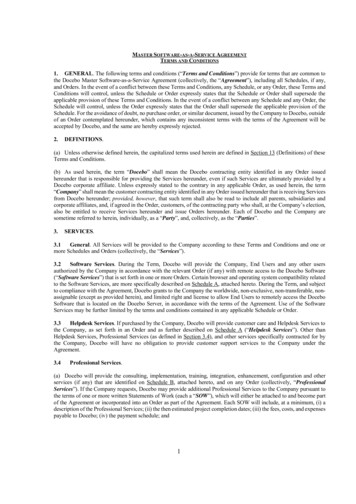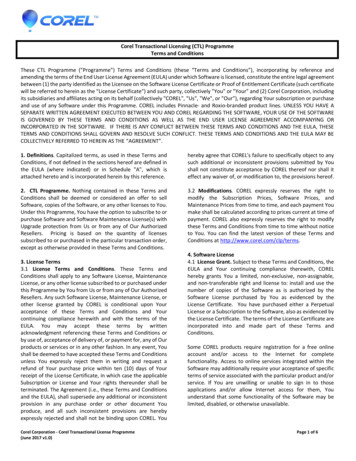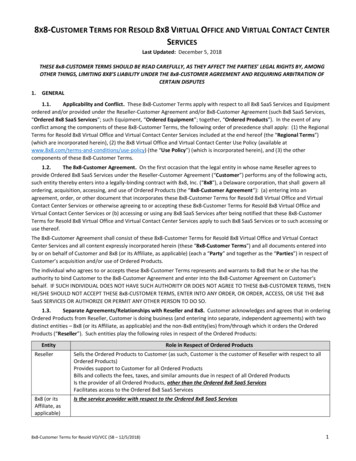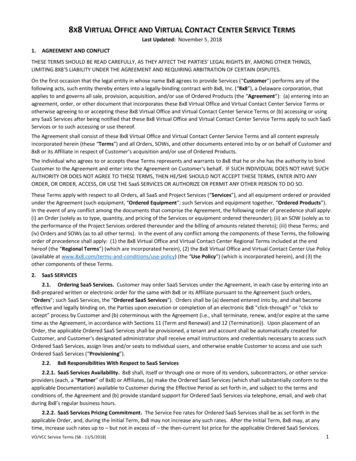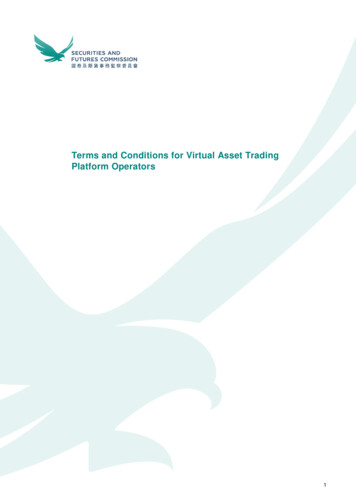
Transcription
Terms and Conditions for Virtual Asset TradingPlatform Operators1
ContentsTerms and Conditions for Virtual AssetTrading Platform Operators3I.Interpretation3II.Codes and Guidelines5III.Financial Soundness5IV.Operations5V.Prevention of Market Manipulative and Abusive Activities9VI.Dealing with Clients10VII.Custody of Client Assets20VIII.Risk Management26IX.Trading Platform and Cybersecurity27X.Conflicts of Interest32XI.Record Keeping34XII.Auditors39XIII.Anti-Money Laundering / Counter-Financing of Terrorism40XIV.Ongoing Reporting / Notification Obligations42Schedule 1 – Existing Regulatory Requirements applicable to aPlatform Operator442
Terms and Conditions for Virtual Asset Trading PlatformOperatorsI. InterpretationA reference in the Terms and Conditions to: “Associated Entity” means a company which (i) has notified the SFC that it hasbecome an “associated entity” of the licensee under section 165 of the Securities andFutures Ordinance (SFO); (ii) is incorporated in Hong Kong; (iii) holds a “trust orcompany service provider licence” under the Anti-Money Laundering and CounterTerrorist Financing Ordinance (Cap. 615); and (iv) is a wholly owned subsidiary of thelicensee; “client” means a person to whom the licensee provides services in the course ofcarrying out the Relevant Activities; “client asset” means client virtual assets and client money; “client money” means any money:(i)(ii)received or held by or on behalf of the licensee orreceived or held by or on behalf of the Associated Entity,which is so received or held on behalf of a client or in which a client has a legal orequitable interests, and includes any accretions thereto whether as capital or income; “client virtual asset” means any virtual asset:(i)(ii)received or held by or on behalf of the licensee orreceived or held by or on behalf of the Associated Entity,which is so received or held on behalf of a client or in which a client has a legal orequitable interests, and includes any rights thereto; “group of companies” has the meaning given by section 1 of Part 1 of Schedule 1 tothe SFO; “licensee” or “Platform Operator” means a legal entity upon which the Terms andConditions are imposed by way of licensing condition pursuant to section 116 of theSFO and that is licensed by the SFC; “Relevant Activities” means any virtual asset trading activities including any incidentalservices provided by the licensee to its clients; “SFO” means the Securities and Futures Ordinance (Cap. 571); and “virtual assets” means digital representations of value which may be in the form ofdigital tokens (such as digital currencies, utility tokens or security or asset-backedtokens), any other virtual commodities, crypto assets or other assets of essentially the3
same nature, irrespective of whether they amount to “securities” or “futures contracts”as defined under the SFO.4
II. Codes and Guidelines2.1In conducting the Relevant Activities, to the extent not already covered elsewhere inthese Terms and Conditions, a Platform Operator is expected to observe theprovisions of the Codes and Guidelines listed in Schedule 1 hereto as if anyreference to a financial product (for example, securities) or investment productincluded virtual assets.III. Financial Soundness3.1In addition to the requirements under the Securities and Futures (FinancialResources) Rules (Cap. 571N), a Platform Operator should maintain in Hong Kong atall times own assets that are sufficiently liquid, for example, cash, deposits, treasurybills and certificates of deposit (but not virtual assets), equivalent to at least 12months of its actual operating expenses calculated on a rolling basis.IV. Operations4.14.2A Platform Operator should set up a function responsible for establishing,implementing and enforcing:(a)the rules which set out the obligations of and restrictions on virtual assetissuers (for example, obligation to notify the Platform Operator of anyproposed hard fork or airdrop, any material change in the issuer’s business orany regulatory action taken against the issuer);(b)the criteria for a virtual asset to be included on its platform, taking into accountfactors specified in paragraph 4.3 below, and the application procedures; and(c)the criteria for halting, suspending and withdrawing a virtual asset from tradingon its platform, the options available to clients holding that virtual asset andany notification periods.A Platform Operator should ensure that the decision-making process of including orremoving virtual assets is transparent and fair.Due diligence on virtual assets4.3A Platform Operator should perform all reasonable due diligence on all virtual assetsbefore including them on its platform for trading, and ensure that they continue tosatisfy all application criteria. Set out below is a non-exhaustive list of factors which aPlatform Operator must consider, where applicable:(a)the background of the management or development team of the issuer of avirtual asset;(b)the regulatory status of a virtual asset in each jurisdiction in which the PlatformOperator provides trading services, including whether the virtual asset can beoffered and traded under the SFO, and whether the regulatory status wouldalso affect the regulatory obligations of the Platform Operator;5
(c)the supply, demand, maturity and liquidity of a virtual asset, including itsmarket capitalisation, average daily trading volume, whether other PlatformOperators also provide trading facilitated for the virtual asset, availability oftrading pairs (eg, fiat currency to virtual asset), and the jurisdictions where thevirtual assets have been offered;(d)the technical aspects of a virtual asset, including the security infrastructure ofthe blockchain protocol underlying the virtual asset, the size of the blockchainand network, in particular, whether it may be susceptible to a 51% attack 1, andthe type of consensus algorithm;(e)the level of activity within the development community;(f)the level of adoption across the ecosystem;(g)the marketing materials of a virtual asset provided by the issuer, which shouldbe accurate and not misleading;(h)the development of a virtual asset including the outcomes of any projectsassociated with it as set out in its Whitepaper (if any) and any previous majorincidents associated with its history and development; and(i)in relation to virtual assets which fall under the definition of “securities” underthe SFO, a Platform Operator should only include those which are (i) assetbacked, (ii) approved or qualified by, or registered with regulators incomparable jurisdictions (as agreed by the SFC from time to time), and (iii)with a post-issuance track record of 12 months.Submission of legal advice for each virtual asset4.4A Platform Operator should obtain and submit to the SFC written legal advice in theform of a legal opinion or memorandum on the legal and regulatory status of everyvirtual asset that will be made available in Hong Kong, in particular, whether thatvirtual asset falls within the definition of “securities” under the SFO, and theimplications for the Platform Operator.4.5A Platform Operator should exercise professional scepticism before relying on anylegal advice, and review such advice with due care and objectivity. In particular, if anyinformation or assumption made in the legal advice is inconsistent with informationknown to the Platform Operator, the Platform Operator should conduct reasonablefollow-up work to resolve the inconsistency and obtain revised legal advice asnecessary.4.6The specific features of a virtual asset may change throughout its life cycle. APlatform Operator should have appropriate monitoring procedures in place to keeptrack of any changes to a virtual asset that may cause its legal status to change suchthat it falls within or ceases to fall within the definition of “securities” in the SFO.1This refers to an attack on a blockchain by a group of miners controlling more than 50% of the network's mining hash rate orcomputing power.6
Trading of virtual assets4.7A Platform Operator should execute a trade for a client only if there are sufficient fiatcurrencies or virtual assets in the client’s account with the Platform Operator to coverthat trade except for any off-platform transaction to be conducted by institutionalprofessional investors 2 which are settled intra-day.4.8A Platform Operator should not provide any financial accommodation 3 for its clients toacquire virtual assets, and should ensure, to the extent possible, that no corporationwithin the same group of companies as the Platform Operator does so.4.9A Platform Operator should not conduct any offering, trading or dealing activities ofvirtual asset futures contracts or related derivatives.4.10A Platform Operator should prepare comprehensive trading and operational rulesgoverning its platform operations for both on-platform trading and off-platform trading(where applicable). These should, at the minimum, cover the following areas:(a)trading and operational matters;(b)trading channels (such as website, dedicated application and applicationprogramming interface (API));(c)trading hours;(d)different types of orders; detailed description of the functionality and theirpriorities;(e)order minimum and maximum quantity limits per underlying currency or virtualasset (in the case of virtual asset trading pairs);(f)order execution conditions and methodology;(g)situations in which orders can be amended and cancelled;(h)trade verification procedures;(i)arrangements during trading suspension, outages and business resumption,including arrangements during restart before entering continuous trading;(j)rules preventing market manipulative and abusive activities;(k)clearing and settlement arrangements;(l)deposit and withdrawal procedures, including the procedures and timerequired for transferring virtual assets from the platform account to a client’sprivate wallet and depositing fiat currencies to a client’s bank account whenreturning client money to the client;2This refers to the specified entities set out in paragraphs (a) to (i) of the definition of “professional investor” in section 1 of Part1 of Schedule 1 to the SFO.3This term is defined in section 1 of Part 1 of Schedule 1 to the SFO.7
4.11(m)custodial arrangements, risks associated with such arrangements, the internalcontrols implemented to ensure that client assets are adequately safeguarded,and insurance / compensation arrangements to protect against any lossesarising from the custody of client virtual assets, if any (see paragraph 7.14below);(n)the internal control procedures which have been put in place to ensure the fairand orderly functioning of its market and to address potential conflicts ofinterest;(o)prohibited trading activities, including, but not limited to, churning, pump-anddump schemes, ramping, wash trading and other market manipulation aimedat creating a false representation of price and/or quantity; and(p)actions the Platform Operator might take should it discover that a client isengaged in prohibited trading activities, including suspension and/ortermination of the client’s account.Where a client is entitled to voting rights arising out of its ownership of a virtual asset,a Platform Operator should inform the client of such rights and facilitate the exerciseof these rights.Fees and charges4.12A Platform Operator should adopt a clear, fair and reasonable fee structure. Inrelation to admission, the fee structure should be designed to avoid any potential,perceived or actual conflicts of interest (for example, charging all virtual asset issuersa flat rate for admission). In relation to trading, the Platform Operator should clearlyset out how different fees may apply based on the type of order (including whetherthe client is providing or taking liquidity), transaction size and type of virtual assetstransacted (if applicable).Market access4.13If the Platform Operator provides programmable access to its platform through one ormultiple channels (API access), thorough and detailed documentation should beprovided to clients. This includes, but is not limited to, detailed descriptions andexamples for all synchronous and asynchronous interactions and events, as well asall potential errors messages. A simulation environment, simulating a reasonableamount of market activity, should be provided for clients to test their applications.8
V. Prevention of Market Manipulative and Abusive ActivitiesInternal policies and controls5.15.2A Platform Operator should establish and implement written policies and controls forthe proper surveillance 4 of its trading platform in order to identify, prevent and reportany market manipulative or abusive trading activities. The policies and controlsshould, at a minimum, cover the following:(a)identifying and detecting anomalies, which includes performing periodicindependent reviews of suspicious price spikes;(b)monitoring and preventing any potential use of abusive trading strategies; and(c)taking immediate steps to restrict or suspend trading upon discovery ofmanipulative or abusive activities (for example, temporarily freezing accounts).Upon becoming aware of any market manipulative or abusive activities, whetheractual or potential, on its trading platform, a Platform Operator should notify the SFCof such matter as soon as practicable, provide the SFC with such additionalassistance in connection with such activities as it might request and implementappropriate remedial measures.Market surveillance system5.3In addition to internal market surveillance policies and controls referred to inparagraph 5.1 above, a Platform Operator should adopt an effective marketsurveillance system provided by a reputable and independent provider to identify,monitor, detect and prevent any market manipulative or abusive activities on itsplatform, and provide access to this system for the SFC to perform its ownsurveillance functions when required.5.4A Platform Operator should review the effectiveness of the market surveillancesystem provided by the independent provider on a regular basis, at least annually,and make enhancements as soon as practicable to ensure that market manipulativeor abusive activities are properly identified. The review report should be submitted tothe SFC upon request.4Surveillance means maintaining a careful watch and supervision for the purposes of influencing, managing or directing theproper use of the virtual asset trading platform.9
VI. Dealing with Clients6.1A Platform Operator should ensure that it complies with the applicable laws andregulations in the jurisdictions to which it provides services. It should establish andimplement measures which include:(a)disclosing to its clients the jurisdictions in which trading of certain virtualassets is permitted;(b)ensuring its marketing activities are only conducted in permitted jurisdictionswithout violation of the relevant restrictions on offers of investments; and(c)implementing measures to prevent persons from jurisdictions which havebanned trading in virtual assets from accessing its services (for example, bychecking IP addresses and blocking access).6.2The Platform Operator may engage in off-platform trading activities as part of itsRelevant Activities. Except for dealing with institutional and qualified corporateprofessional investors 5, a Platform Operator should ensure that when it carries on theRelevant Activities (other than the on-platform trading activities in compliance withparagraphs 6.3 and 6.7 below and without solicitation and recommendation 6), atransaction in virtual assets is suitable for the client in all the circumstances. 7 APlatform Operator should perform all reasonable due diligence on the virtual assetsbefore including them on its platform (see paragraph 4.3 above) and provide sufficientand up-to-date information on the nature, features and risks of these virtual assets(see also paragraph 6.15(d) below) on its website in order to enable clients tounderstand them before making an investment decision.6.3Posting of any advertisement in connection with a specific virtual asset on theplatform is prohibited. Where a Platform Operator decides to post any productspecific materials on the platform, it should ensure that such materials are factual, fairand balanced.Access to trading services6.4As required by its licensing conditions a Platform Operator should provide its virtualasset trading services only to professional investors.6.5Where a Platform Operator provides its trading platform to other companies (ie, whitelabelling), which may in turn provide such services to their clients, the PlatformOperator should take all reasonable steps to ensure that all such clients and endusers of its platform are professional investors if the ultimate client’s transactions are5Same definitions in paragraph 15 of the Code of Conduct for Persons Licensed by or Registered with the SFC (Code ofConduct). “Qualified corporate professional investors” refers to corporate professional investors who have passed theassessment requirements under paragraph 15.3A and gone through the procedures under paragraph 15.3B of the Code ofConduct.6Please refer to the examples set out in Q15 of the frequently asked questions on Guidelines on Online Distribution andAdvisory Platforms and Paragraph 5.5 of the Code of Conduct regarding when the posting of materials would or would nottrigger the suitability requirement.7See paragraphs 5.2 and 5.5 of the Code of Conduct.10
to be routed to and executed on the same platform as those of the PlatformOperator’s direct clients.Account opening and know your client6.6A Platform Operator should take all reasonable steps to establish the true and fullidentity of each of its clients, and of each client’s financial situation, investmentexperience, and investment objectives. 8 Where a client’s IP address is masked (forexample, where access is via a virtual private network), a Platform Operator shouldtake reasonable steps to unmask the IP address or decline to provide services to thatclient where necessary.6.7Except for institutional and qualified corporate professional investors 9, a PlatformOperator should assess a client’s knowledge of virtual assets (including knowledge ofrelevant risks associated with virtual assets) before providing any services to theclient. The following are some criteria (which are not exhaustive) for assessing if aclient can be regarded as having knowledge of virtual assets:(a)undergone training or attended courses on virtual assets;(b)current or previous work experience related to virtual assets; or(c)prior trading experience in virtual assets.A client will be considered as having knowledge of virtual assets if he has executedfive or more transactions in any virtual assets within the past three years.6.8Where a client does not possess such knowledge, a Platform Operator may onlyprovide any of its services to the client if the Platform Operator has provided trainingto the client and enquired into the personal circumstances of the client to ensure thatprovision of its services is suitable for that client.6.9A Platform Operator should set a trading limit, position limit or both with reference tothe client’s financial situation with a view to ensuring that the client has sufficient networth to be able to assume the risks and bear the potential trading losses.6.10A Platform Operator should not allow a single client to open multiple accounts, unlessin the form of sub-accounts.Client identity: origination of instructions and beneficiaries6.11A Platform Operator should be satisfied on reasonable grounds about:(a)(b)89the identity, address and contact details of:(i)the person or entity (legal or otherwise) ultimately responsible fororiginating the instruction in relation to a transaction;(ii)the person or entity (legal or otherwise) that stands to gain thecommercial or economic benefit of the transaction and/or bear itscommercial or economic risk; andthe instruction given by the person or entity referred to in paragraph6.11(a)(i) above.See paragraph 5.1 of the Code of Conduct.Please see footnote 5 above.11
6.12A Platform Operator should not do anything to effect a transaction unless it hascomplied with paragraph 6.11 above and kept records in Hong Kong of the detailsreferred to in paragraph 6.11 above.Client agreement6.13In conducting any Relevant Activities, a Platform Operator should enter into a writtenclient agreement with each and every client 10 in the same manner as set out inparagraph 6 of the Code of Conduct and include a provision stating that:“In conducting any Relevant Activities, if we [the Platform Operator] solicit thesale of or recommend any product including any virtual assets to you [theclient], the product must be reasonably suitable for you having regard to yourfinancial situation, investment experience and investment objectives. No otherprovision of this agreement or any other document we may ask you to signand no statement we may ask you to make derogates from this clause.”Disclosure6.1410A Platform Operator should fully disclose the nature and risks that clients may beexposed to in trading virtual assets and using the Platform Operator’s virtual assettrading services. All information provided to clients should be presented in a clear andfair manner which is not misleading. The disclosed risks should, among other things,include:(a)virtual assets are highly risky and investors should exercise caution in relationto the products;(b)a virtual asset may or may not be considered as “property” under the law, andsuch legal uncertainty may affect the nature and enforceability of a client’sinterest in such virtual asset;(c)the offering documents or product information provided by the issuer have notbeen subject to scrutiny by any regulatory body;(d)the protection offered by the Investor Compensation Fund does not apply totransactions involving virtual assets (irrespective of the nature of the tokens);(e)a virtual asset is not legal tender, ie, it is not backed by the government andauthorities;(f)transactions in virtual assets may be irreversible, and, accordingly, losses dueto fraudulent or accidental transactions may not be recoverable;(g)the value of a virtual asset may be derived from the continued willingness ofmarket participants to exchange fiat currency for a virtual asset, which meansthat the value of a particular virtual asset may be completely and permanentlylost should the market for that virtual asset disappear. There is no assuranceExcept for institutional and qualified corporate professional investors (see footnote 5 for definitions).12
that a person who accepts a virtual asset as payment today will continue to doso in the future;6.15(h)the volatility and unpredictability of the price of a virtual asset relative to fiatcurrencies may result in significant losses over a short period of time;(i)legislative and regulatory changes may adversely affect the use, transfer,exchange and value of virtual assets;(j)some virtual asset transactions may be deemed to be executed only whenrecorded and confirmed by the Platform Operator, which may not necessarilybe the time at which the client initiates the transaction;(k)the nature of virtual assets exposes them to an increased risk of fraud orcyberattack; and(l)the nature of virtual assets means that any technological difficultiesexperienced by the Platform Operator may prevent clients from accessingtheir virtual assets.A Platform Operator should, at a minimum, also make the following informationavailable on its website:(a)its services are only available to professional investors;(b)its trading and operational rules as well as admission and removal rules andcriteria;(c)its admission and trading fees and charges, including illustrative examples ofhow the fees and charges are calculated, for ease of understanding by clients;(d)the relevant material information for each virtual asset, including providingclients with access to up-to-date offering documents or information, andproviding clients with material information as soon as reasonably practicableto enable clients to appraise the position of their investments (for example,any major events in relation to a virtual asset or any other material informationprovided by issuers);(e)the rights and obligations of the Platform Operator and the client;(f)arrangements for dealing with settlement failures in respect of transactionsexecuted on its platform;(g)detailed documentation of market models, order types and trading rules aswell as deposit and withdrawal processes for fiat currencies and virtual assets(where applicable);(h)if API access is offered, detailed documentation regarding differentconnectivity channels, all synchronous and asynchronous requests andresponses, market events, error messages and all other messages. Thedocumentation should also include detailed examples for each of thesematters;13
(i)detailed documentation regarding the simulation environment as well asconstant and active simulated quote and order feed into the simulationenvironment;(j)client’s liability for unauthorised virtual asset transactions;(k)client’s right to stop payment of a preauthorised virtual asset transfer and theprocedure for initiating such a stop-payment order;(l)circumstances under which the Platform Operator may disclose the client’spersonal information to third parties, including regulators and auditors;(m)client’s right to prior notice of any change in the Platform Operator’s rules,procedures or policies;(n)dispute resolution mechanisms, including complaints procedures; and(o)system upgrades and maintenance procedures and schedules.The Platform Operator should, as soon as practicable thereafter, publish anyrevisions or updates on its website and circulate them to the users of its platforms,identifying the amendments which have been made and providing an explanation formaking them.Provision of prompt confirmation to clients6.166.17Prior to the execution of each transaction in virtual assets, a Platform Operator shouldconfirm with its clients the following terms:(a)name of the virtual asset in the proposed transaction;(b)amount or value of the proposed transaction;(c)fees and charges to be borne by the client including applicable exchangerates; and(d)a warning that once executed the transaction may not be undone.After a Platform Operator has effected a transaction for a client, it should confirmpromptly with the client the essential features of the transaction. The followinginformation should be included:(a)name of the virtual asset in the transaction;(b)amount or value of the transaction; and(c)fees and charges borne by the client including applicable exchange rates.14
Provision of contract notes, statements of account and receipts to clients6.18A Platform Operator should provide to each client timely and meaningful informationabout transactions conducted with or on the client’s behalf, consisting of holdings andmovements of the client virtual assets and fiat currencies, and a monthly statement ofall activities and holdings in the client’s account. Where contract notes, statements ofaccount and receipts are provided by a Platform Operator to a client, the PlatformOperator should ensure that the information included in the contract notes,statements of account and receipts should be fit for purpose, comprehensive andaccurate in respect of the particular type of virtual asset involved. In particular:Contract notes(a)Where a Platform Operator enters into a relevant contract with or on behalfof a client, it must prepare and provide a contract note to the client no laterthan the end of the second business day after entering into the relevantcontract. The term “relevant contract” means a contract, entered into inHong Kong by a Platform Operator with or on behalf of a client in theconduct of its businesses which constitute any Relevant Activity, that is acontract for dealing in virtual assets.(b)Where a Platform Operator enters into more than one relevant contract withor on behalf of a client on the same day, unless the client has givencontrary instructions to the Platform Operator, the Platform Operator mayprepare a single contract note which:(i)records all of those relevant contracts; and(ii)in respect of each of those relevant contracts includes all of theinformation which would have been required to be included in thecontract note.(c)If such a single contract note is prepared, the Platform Operator shouldprovide it to the client no later than the end of the second business dayafter entering into those relevant contracts.(d)A contract note should include, to the extent applicable, the followinginformation:(i)the name under which the Platform Operator carries on business;(ii)the name and account number of the client;(iii)full particulars of the relevant contract including:(1)the quantity, name, description and such other particularsof the virtual asset contract involved, as are sufficient toenable it to be identified;(2)the nature of the dealing;15
(3)where the Platform Operator is acting as principal, anindication that it is so acting;(4)the date (i) on which the relevant contract is entered into;(ii) of settlement or performance of the relevant contract;and (iii) on which the contract note is prepared;(5)the price per unit of the virtual asset traded;(6)the amount of consideration payable under the relevantcontract; and(7)the rate or amount of fees and charges payable inconnection with the relevant contract.Monthly Statements of Account(e)(f)(g)Where any of the following circumstances apply, a Platform Operatorshould prepare and provide a monthly statement of account to the client nolater than the end of the seventh business day after the end of the monthlyaccounting period:(i)during a monthly accounting period, the Platform Operator isrequired to prepare and provide to the client a contract note orreceipt;(ii)at any time during a
4.2 A Platform Operator should ensure that the decisionmaking process of - including or removing virtual assets is transparent and fair. Due diligence on virtual assets . 4.3 A Platform Operator should perform all reasonable due diligence on all virtual assets before including them on its platform for trading, and ensure that they continue to







